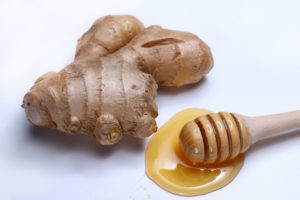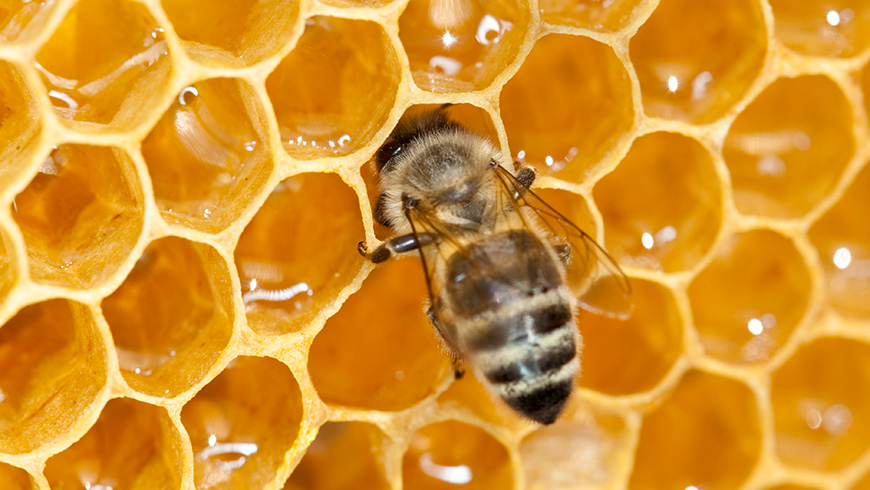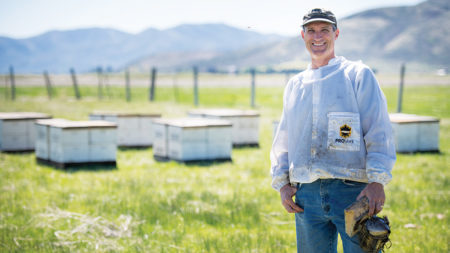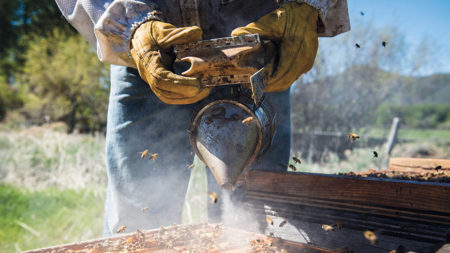Unless you live on a farm or have taken up backyard beekeeping, honey, a household staple, comes in a jar or bottle from the grocery store. The sticky, sweet, golden nectar sits patiently on a shelf in your pantry, waiting to be spooned into a cup of hot tea (or whiskey). It dreams of being spooned into a batter of muffins, into a Southern barbecue sauce to dance with spice, drizzled over pungent cheese, or spread onto a piece of hot, buttered toast.
You might not often think about that jar of honey in your pantry, but there is a story there: A tale of a long and arduous journey from bee to bottle. It’s a story about home.
A Short History of Honey
Honey and humans go back a long way. A cave painting discovered in Spain, dated from 8,000 B.C., depicted a human climbing a tree with a bucket in one hand and bees buzzing all around. Considered the “nectar of the gods,” early Egyptians took earthen jars of honey to the tomb. Ancient Roman writers—Pliny, Cicero, Seneca—waxed poetic about the virtues of the viscous liquid, from its medicinal powers to the sensual response elicited when honey touches the tongue.
“What a gift it would have been to give someone a honeycomb,” said Tom Harned, owner of Five Bee Hives, based in Hailey, Idaho.
Even after the domestication of sugar cane, coined at the time as “the reed which gives honey without bees,” apiculture—beekeeping—thrived. One reason was honey wasn’t solely a sweetener with a unique taste, but also an antiseptic. Honey is antifungal and antibacterial.
“Nothing grows on it,” Harned said.
Spread on wounds, honey helped prevent infection. Stirred into hot liquids, honey soothed sore throats. There is growing evidence honey has innate abilities to boost the immune system, and some naturalists believe that eating honey produced from “local” flora can aid in developing resistance to plant allergies.
Five Bee Hives
Harned, a quiet, former stay-at-home dad, discovered beekeeping in 2010 after visiting a college friend, a beekeeper, in Montana. Looking for his next career move, Harned returned home from Montana with four hives. Shortly after, he purchased 40 more hives and began an eight-year journey in apiculture that has blossomed into 800 hives.
Five Bee Hives honey—a tongue-and-cheek play on the 5B Blaine County license plate—is made and harvested in the Wood River Valley from about 400 hives. Harned’s remaining 400 hives live in Montana, and their honey is sold on the open market.
Harned said eight species of bees produce honey, but the Apis mellifera, the “honeybee,” is the only bee that makes honey in excess—extreme excess. Bumblebees and some wasps make honey, but only enough to feed themselves. Bees eat pollen and nectar: pollen is their protein; flower nectar is their carbohydrate.
The hive is “home.” Some leave the home to forage for food while others never leave, keeping house by constructing honeycomb, making honey, and tending to the queen. Commercial beekeepers, like Harned, move the hives throughout the year. Harned’s bees winter in a potato shed in southeastern Idaho. In January, he loads them onto a semi-trailer and trucks them to California to an almond farm, where the hives are spread around the orchard to pollinate the trees. A couple months, give or take, later, the bees are loaded back onto a semi headed for Washington State, to lend a pollinating hand to an apple and cherry farmer. In late spring, the bees return to the Wood River Valley and Harned sets them out in fields and yards where they stay until the snow comes.
“People ask me, when you move them around, how do you get the bees to go back into their hive. Well, they’re a lot like us,” Harned said. “When we go to a city and rent a hotel, we orient ourselves to where we are. Bees do the same thing. They start with orientation flights, but their particular hive is their home, and they will always come back to it.”
Forager bees fly out of the hive to collect pollen and nectar, which they store in what is called a “honey stomach”—part of their esophagus—to bring back to the hive. The collections are dropped off to other worker bees that then deposit the “receipts” into cells in the honeycomb, which they’ve constructed by converting the sugar content of honey into wax.
“Nectar is about 70 percent water,” Harned said. “Bees evaporate that water by flapping their wings until the nectar is about 18 percent moisture. At that point, it won’t rot or ferment.”
When a cell is full and the moisture is reduced, bees cap it off with more wax. Harned harvests honey in late summer, but inspects the hives frequently throughout the season, looking for signs that the hive is thriving. Is the queen doing her job laying 1,000 or more eggs a day? If the queen isn’t doing her job, Harned kills her. But don’t judge him. He is doing what the hive would do if the queen weren’t up to snuff.
“When you look at the hive as a whole,” he said, “the way they make decisions is very democratic. They each have input. The queen is not the ruler. She’s just the egg-layer. And if she isn’t performing, they will kill her and designate a new queen.”
One bee will make a quarter-teaspoon of honey in its lifetime, which is all of six weeks, although a queen can live up to five years, as long as she keeps delivering eggs. Roughly 30,000 to 60,000 bees live in a hive, and while there is constant turnover, they all come from roughly the same bloodline. Harned gathers around 30 pounds of honey per hive from his Wood River Valley operation, roughly 12,000 pounds of honey a year for consumption by Wood River Valley residents, either at home or through dishes served by local chefs.
Honey at Home and in the Professional Kitchen
Chris Kastner of CK’s Real Food in Hailey uses Five Bee Hives honey in his restaurant throughout the seasons, both in savory and sweet applications.
“I like its caramelizing properties,” Kastner said. He uses Five Bee Hives honey when roasting carrots, turnips, fennel and even lemons. “I also like its soft sweetness in tea, and the deep honey flavor in honey-sweetened cake.”
Kastner isn’t the only local chef to use Five Bee Hives honey. You’ll find a stash of Harned’s honey in the Power House and The Smokey Bone BBQ kitchens, both in Hailey. Rasberrys Bistro and Catering in Ketchum sweetens their offerings with Five Bee Hives honey, and local Toni’s Sun Valley Ice Cream Company uses Harned’s honey to make its honey-and-chamomile flavor.
Baking at home, in general, you can swap out granulated sugar with honey with a couple of modifications. Honey tastes sweeter than cane sugar, so the first adjustment is reducing the amount. The rule of thumb is for each cup of sugar, substitute one-half to two-thirds of a cup of honey. Honey is also almost 20 percent water, so reduce the total amount of liquid by 20 percent. You may have to adjust that percentage up or down to suit the specific recipe.
You can buy Five Bee Hives honey at all three Atkinsons’ Markets and at Maude’s Coffee & Clothes.
For a simple summer recipe, try the honey ginger lime dressing (sidebar) with poppy seeds drizzled over a bowl of ripe melon chunks or tossed with blueberries and blackberries to garnish a simple glazed pound cake.
The next time you reach for that jar of honey on your shelf, think about the journey the bees traveled from field to hive—perhaps farther—to return “home.”
For human or honeybee, there’s no place like home.

HONEY GINGER LIME DRESSING
by Gwen Ashley Walters
1 teaspoon fresh grated ginger
2 teaspoons lime zest
1/2 cup fresh squeezed lime juice
(about 4-5 limes)
1/2 cup Five Bee Hives honey
2 teaspoons poppy seed
Stir the ginger with the lime zest and juice. Set aside for 30 minutes to steep. Strain the lime-ginger mixture and whisk in the honey and poppy seeds. Drizzle over fresh-cut melons (especially honeydew), or over other fruit.
Makes 1-1/2 cups.




